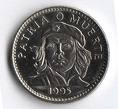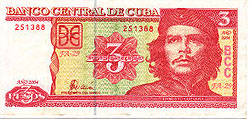|


The peso (ISO 4217 code: CUP, sometimes called the "national peso" or in Spanish moneda nacional) is one of two official currencies in use in Cuba, the other being the convertible peso (ISO 4217 code: CUC, occasionally referred to as "dollar" in spoken language). It is subdivided into 100 centavos.
Cuban state workers receive a portion of their wages in convertible pesos, the rest in national pesos. Shops selling basics, like fruit and vegetables, generally only accept the normal peso, while "dollar shops" sell the rest. The word "pesos" may refer to both non-convertible and convertible money. Cuban convertible pesos are 25 times more valuable, but this does not completely eliminate the confusion for tourists: since goods bought in national pesos have controlled prices, tourists are sometimes confused by prices perceived as "too cheap".
History
Before 1857, Spanish and Spanish colonial reales circulated in Cuba. From 1857, banknotes were issued specifically for use on Cuba. These were denominated in pesos, with 1 peso = 8 reales. From 1869, notes were also issued denominated in centavos, with 100 centavos = 1 peso. In 1881, the peso was pegged to the U.S. dollar at par. The currency continued to be issued only in paper form until 1915, when the first coins were issued.
In 1960, the peg to the dollar was replaced by one to the Soviet ruble. The peso lost value due to the United States embargo against Cuba and the suspension of the sugar quota. This suspension was the principal economical force driving Cuba to seek out a new economic partner, the Soviet Union. When the Soviet Union dissolved in 1991, the peso lost much of its value and the exchange rate fell to 125 pesos to the USD. Recently, it has become more valuable, fluctuating between 23 and 25 pesos to the dollar.
In 1993, during the period of economic austerity known as the Special Period, the US dollar was made legal tender to encourage hard currency to enter the economy. The dollar became the currency used to purchase some non-essential goods and services, such as cosmetics, and even non-staple kinds of food and drink. In 1994, the convertible peso was introduced at a par with the dollar. On November 8, 2004, the Cuban government withdrew the U.S. dollar from circulation, citing the need to retaliate against further U.S. sanctions.
Coins
In 1915, cupro-nickel 1, 2 and 5 centavos, silver 10, 20 and 40 centavos and 1 peso, and gold 1, 2, 4, 10 and 20 peso coins were introduced. These coins were designed by Charles E. Barber, who also designed the Barber dimes, quarters, half dollars for the US. The coins were minted at the US mint at Philadelphia. The gold coins and 2 centavos were not produced after 1916, with the silver 1 peso ceasing production in 1934. Brass 1 and 5 centavos were issued in 1943. 10 centavo coins were last produced in 1952. In 1953, silver 25 and 50 centavo coins were issued. These were the last silver coins issued for circulation. The last US produced coin was the 1961 five centavo piece.
In 1962, cupro-nickel 20 and 40 centavos were introduced, followed in 1963 by aluminium 1 and 5 centavos. In 1969, aluminium 20 centavos were introduced, followed by aluminium 2 centavos and brass 1 peso in 1983. Cupro-nickel 3 peso coins were introduced in 1990, with brass-plated-steel 1 peso and nickel-clad-steel 3 peso coins following in 1992. 40 centavo coins were withdrawn from circulation around July 2004 and are no longer accepted as payment. Coins currently in circulation are 1, 2, 5 and 20 centavos and 1 and 3 pesos.
Between 1981 and 1989, the National Institute of Tourism (Instituto Nacional de Turismo, "INTUR") issued "Visitors Coinage" for use by tourists. In 1981, cupro-nickel 5, 10, 25 and 50 centavos and 1 peso were introduced, followed in 1988 by aluminium 1, 5, 10, 25 and 50 centavos. The INTUR coins were demonetized on October 15, 2001, and were replaced by fractional convertible pesos in 1, 5, 10, 25, 50 centavos and 1 peso, minted in Canada. In late 2004, a five convertible peso coin, dated 1999, was placed into circulation.
Banknotes
In 1857, the Banco Español de la Habana introduced notes in denominations of 50, 100, 300, 500 and 1000 pesos. 25 peso notes were introduced in 1867, followed by 5 and 10 pesos in 1869. During the Ten Years' War, notes were issued dated 1869 in the name of the Republic of Cuba in denominations of 50 centavos, 1, 5, 10, 50, 500 and 1000 pesos.
In 1872, 5, 10, 25 and 50 centavo, and 1 and 3 peso notes were introduced by the Banco Español de la Habana. In 1891, the Treasury issued notes for 5, 10, 20, 50, 100 and 200 pesos. In 1896, the name of the bank changed to the Banco Español de la Isla de Cuba and issued notes in denominations of 5 and 50 centavos, 1, 5 10, 50, 100, 500 and 1000 pesos, followed by 10 and 20 centavos in 1897.
In 1905, the National Bank of Cuba (Banco Nacional de Cuba) issued notes for 1, 2, 5 and 50 pesos. However, the 1905 banknotes were not issued (source: Pick's catalog) In 1934, the Government introduced silver certificates (certificados de plata) in denominations of 1, 5, 10, 20 and 50 pesos, followed by 100 pesos in 1936 and 500 and 1000 pesos in 1944.
In 1949, the Banco Nacional de Cuba resumed paper money production, introducing 1, 5, 10 and 20 peso notes that year, followed by 50, 100, 500, 1000 and 10,000 peso notes in 1950. Denominations above 100 pesos were not continued. In January 1961, all previous bank notes were demonetized, with new bank notes, printed in Czechoslovakia, placed into circulation. 3 peso notes were added in 1983. The 1961 bank notes were demonetized on May 1, 2002 (source: Banco Central Cuba, Granma, February 27, 2002) Banknotes currently in circulation are 1, 3, 5, 10, 20, 50 and 100 pesos.
The CUP and the CUC
The peso (CUP) is used by tourists only for staple and non-luxury products. However, local citizens are paid most of their wages in pesos and have to pay everyday expenses in CUP. For some accounting purposes the exchange rate is set at 1 CUP = 1 CUC. However, for practical purposes, the exchange rate is that applied by the Cuban banks and Cadecas (exchange bureaux). From March 18, 2005, that rate has been set at 1:24 when exchanging CUC for CUP and 25:1 when going from CUP to CUC. The convertible peso is currently pegged at $1.08 USD and is used for luxury products and services. All other exchanges rates are set in relation to the CUC.
The text on this page has been made available under the Creative Commons Attribution-ShareAlike License and Creative Commons Licenses
|
